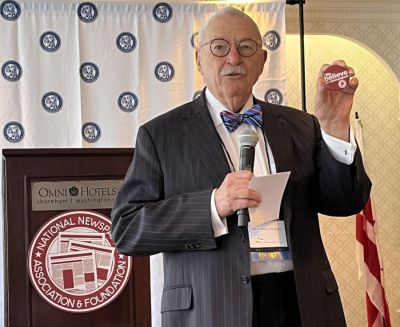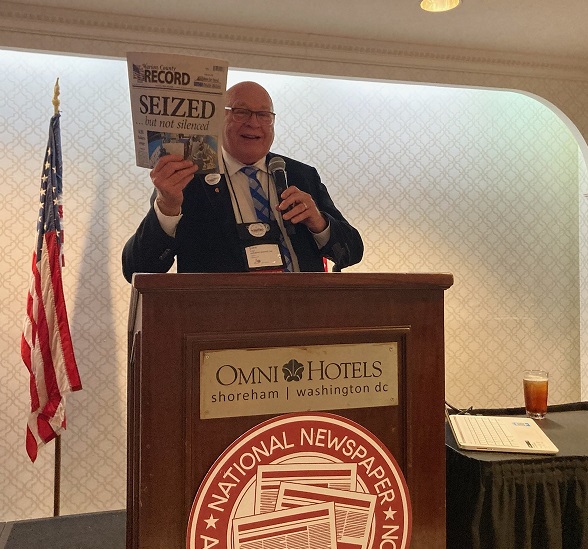Murdaugh trial can be a model for how judges balance free press and fair trial issues
Benjy Hamm
Nov 1, 2023

The Alex Murdaugh murder trial in South Carolina is a good example of how a judge can balance the free press needs of the media with the defendant’s fundamental right to a fair trial, according to Jay Bender, a veteran First Amendment attorney.
Bender spoke at the NNAF Annual Convention & Trade Show in Washington, D.C., on Sept. 30 about his role in helping Circuit Court Judge Clifton Newman provide journalists with good access to the high-profile trial while also ensuring that the media abided by the rules and decorum established by the judge.
The trial in Walterboro, which is about an hour west of Charleston, attracted regional, national and international coverage in newspapers, online news sites, radio and TV broadcasts, blogs, podcasts and documentaries. The trial lasted for six weeks before Murdaugh was convicted on March 2 of murdering his wife and a son at their family farm.
“People all over the world watched this trial,” Bender said.
But they would not have been able to see it without Judge Newman’s help. South Carolina’s rules regarding cameras in the courtroom give each judge the discretion on whether to allow photo and video coverage.
“There are some judges who don’t like cameras,” Bender said, and thus don’t allow them. But he said Newman recognized the importance of including cameras as part of the broader coverage.
Another major consideration involved determining the best ways to provide seating and coverage in the 200-year-old Colleton County Courthouse that Bender said was small, didn’t provide the best views and could be a difficult place to hear the proceedings.
The courtroom had space for about 15 journalists, and that was not nearly enough room for the up to 50 reporters who wanted to attend some days. So, Newman issued an order establishing reserved seats each day for the local and statewide media who had been covering the case from the beginning, in addition to national media organizations such as the Wall Street Journal, New York Times and TV outlets.
The judge’s decision meant that two local community newspapers, the Press and Standard of Walterboro and the Hampton County Guardian, would not be squeezed out by larger media organizations.
The judge also reserved seats for two bloggers and podcasters who had covered the case extensively. Several other media seats were offered up in a lottery that journalists could enter each day.
Town officials also set up an overflow media facility in the Wildlife Center across the street from the courthouse. Bender said the overflow room was a much better place to watch the trial because it had tables, chairs and a video and audio feed of all the proceedings taking place in the courtroom.
Court TV provided video and audio feeds for the trial, while photographers from The State newspaper in Columbia and the Post and Courier in Charleston were chosen as pool photographers to provide still images. The photographers also were given 30 minutes each day after the trial had recessed to take photographs of documents introduced as evidence.
The way Newman and the town of Walterboro handled the media can serve as a model for other major trials across the country, Bender said.
Bender said the media must do their part to make sure everything operates smoothly during a trial. Among his suggestions are:
- Understand and abide by the rules of the court. For example, South Carolina does not allow the use of cellphones in courtrooms, although some reporters have been known to forget that rule or try to get around it. To make sure every journalist knew the rule, Bender handed out reporters’ notebooks with a reminder printed on the cover, “You have entered the no phone zone.”
- Respect the courtroom environment with your dress and manner. That means dressing professionally and not in shorts and a T-shirt (yes, Bender says that has happened more than once).
- Reach out to the judge in advance about a major case to discuss the media’s interests. A state press association attorney often can help with legal requests.
On a personal note, I worked with Jay as a legal source for civil and criminal cases I covered while working as a reporter for The Associated Press in South Carolina. And the newspapers I’ve worked with later used Jay as an attorney in our First Amendment cases in South Carolina, where he served as general counsel to the South Carolina Press Association. His legal knowledge, experience with the media and engaging personality made him the ideal choice to help in the Murdaugh case.
Murdaugh is appealing his murder convictions, but Bender said even though he enjoyed his role as media liaison for the first trial, he does not plan to return if the case is tried again.
“I paid my debt to society,” he said.
Bender encourages newspapers to run this document encouraging the allowance of camera coverage of the Trump prosecutions.
Benjy Hamm is director of the Institute for Rural Journalism at the University of Kentucky. He previously served as editorial director for Landmark Community Newspapers and also worked as an editor for newspapers in South Carolina and Virginia. He can be reached at benjy.hamm@uky.edu.








